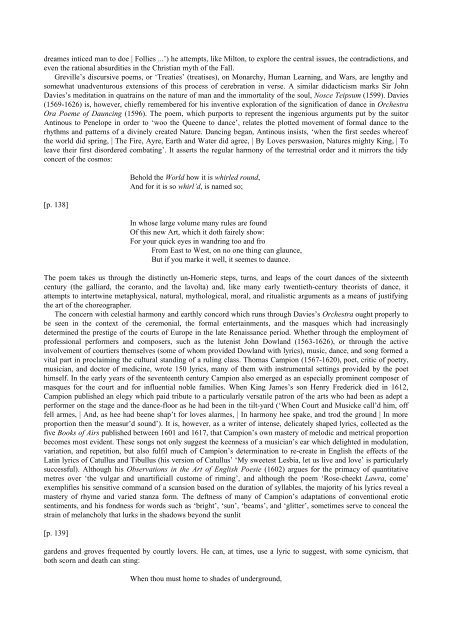THE SHORT OXFORD HISTORY OF ENGLISH LITERATURE
THE SHORT OXFORD HISTORY OF ENGLISH LITERATURE
THE SHORT OXFORD HISTORY OF ENGLISH LITERATURE
You also want an ePaper? Increase the reach of your titles
YUMPU automatically turns print PDFs into web optimized ePapers that Google loves.
dreames inticed man to doe | Follies ...’) he attempts, like Milton, to explore the central issues, the contradictions, and<br />
even the rational absurdities in the Christian myth of the Fall.<br />
Greville’s discursive poems, or ‘Treaties’ (treatises), on Monarchy, Human Learning, and Wars, are lengthy and<br />
somewhat unadventurous extensions of this process of cerebration in verse. A similar didacticism marks Sir John<br />
Davies’s meditation in quatrains on the nature of man and the immortality of the soul, Nosce Teipsum (1599). Davies<br />
(1569-1626) is, however, chiefly remembered for his inventive exploration of the signification of dance in Orchestra<br />
Ora Poeme of Dauncing (1596). The poem, which purports to represent the ingenious arguments put by the suitor<br />
Antinous to Penelope in order to ‘woo the Queene to dance’, relates the plotted movement of formal dance to the<br />
rhythms and patterns of a divinely created Nature. Dancing began, Antinous insists, ‘when the first seedes whereof<br />
the world did spring, | The Fire, Ayre, Earth and Water did agree, | By Loves perswasion, Natures mighty King, | To<br />
leave their first disordered combating’. It asserts the regular harmony of the terrestrial order and it mirrors the tidy<br />
concert of the cosmos:<br />
[p. 138]<br />
Behold the World how it is whirled round,<br />
And for it is so whirl’d, is named so;<br />
In whose large volume many rules are found<br />
Of this new Art, which it doth fairely show:<br />
For your quick eyes in wandring too and fro<br />
From East to West, on no one thing can glaunce,<br />
But if you marke it well, it seemes to daunce.<br />
The poem takes us through the distinctly un-Homeric steps, turns, and leaps of the court dances of the sixteenth<br />
century (the galliard, the coranto, and the lavolta) and, like many early twentieth-century theorists of dance, it<br />
attempts to intertwine metaphysical, natural, mythological, moral, and ritualistic arguments as a means of justifying<br />
the art of the choreographer.<br />
The concern with celestial harmony and earthly concord which runs through Davies’s Orchestra ought properly to<br />
be seen in the context of the ceremonial, the formal entertainments, and the masques which had increasingly<br />
determined the prestige of the courts of Europe in the late Renaissance period. Whether through the employment of<br />
professional performers and composers, such as the lutenist John Dowland (1563-1626), or through the active<br />
involvement of courtiers themselves (some of whom provided Dowland with lyrics), music, dance, and song formed a<br />
vital part in proclaiming the cultural standing of a ruling class. Thomas Campion (1567-1620), poet, critic of poetry,<br />
musician, and doctor of medicine, wrote 150 lyrics, many of them with instrumental settings provided by the poet<br />
himself. In the early years of the seventeenth century Campion also emerged as an especially prominent composer of<br />
masques for the court and for influential noble families. When King James’s son Henry Frederick died in 1612,<br />
Campion published an elegy which paid tribute to a particularly versatile patron of the arts who had been as adept a<br />
performer on the stage and the dance-floor as he had been in the tilt-yard (‘When Court and Musicke call’d him, off<br />
fell armes, | And, as hee had beene shap’t for loves alarmes, | In harmony hee spake, and trod the ground | In more<br />
proportion then the measur’d sound’). It is, however, as a writer of intense, delicately shaped lyrics, collected as the<br />
five Books of Airs published between 1601 and 1617, that Campion’s own mastery of melodic and metrical proportion<br />
becomes most evident. These songs not only suggest the keenness of a musician’s ear which delighted in modulation,<br />
variation, and repetition, but also fulfil much of Campion’s determination to re-create in English the effects of the<br />
Latin lyrics of Catullus and Tibullus (his version of Catullus’ ‘My sweetest Lesbia, let us live and love’ is particularly<br />
successful). Although his Observations in the Art of English Poesie (1602) argues for the primacy of quantitative<br />
metres over ‘the vulgar and unartificiall custome of riming’, and although the poem ‘Rose-cheekt Lawra, come’<br />
exemplifies his sensitive command of a scansion based on the duration of syllables, the majority of his lyrics reveal a<br />
mastery of rhyme and varied stanza form. The deftness of many of Campion’s adaptations of conventional erotic<br />
sentiments, and his fondness for words such as ‘bright’, ‘sun’, ‘beams’, and ‘glitter’, sometimes serve to conceal the<br />
strain of melancholy that lurks in the shadows beyond the sunlit<br />
[p. 139]<br />
gardens and groves frequented by courtly lovers. He can, at times, use a lyric to suggest, with some cynicism, that<br />
both scorn and death can sting:<br />
When thou must home to shades of underground,









